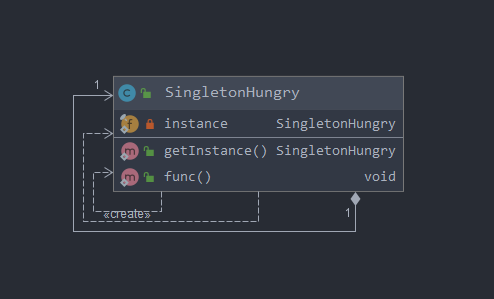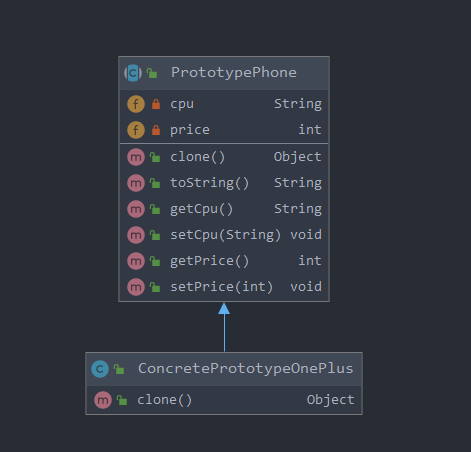您好,登錄后才能下訂單哦!
您好,登錄后才能下訂單哦!
本篇內容主要講解“什么是單例模式與原型模式”,感興趣的朋友不妨來看看。本文介紹的方法操作簡單快捷,實用性強。下面就讓小編來帶大家學習“什么是單例模式與原型模式”吧!
單例模式應該算是最常用的設計模式了叭,著名的雙重校驗也是單例模式的一種實現。所謂單例模式就是用來保證一個對象只能創建一個實例,除此之外,它還提供了對實例的全局訪問方式。

所謂餓漢式,人餓了看到啥都想吃。同樣,不管需不需要這個實例,反正我都先給你創建好。
普通實現
public class SingletonHungry {
//在類加載的時候就已經創建了唯一的實例
private static final SingletonHungry instance = new SingletonHungry();
//保證外部不能調用構造函數
private SingletonHungry() {
}
//外部調用這個方法,就返回實例
public static SingletonHungry getInstance() {
return instance;
}
//類中其它方法,盡量是static
public static void func(){}
}靜態代碼塊
public class SingletonHungryStatic {
//其實就是把new的部分移到了靜態代碼塊中
private static SingletonHungryStatic instance = null;
static {
instance = new SingletonHungryStatic();
}
private SingletonHungryStatic() {
}
public static SingletonHungryStatic getInstance() {
return instance;
}
//類中其它方法,盡量是static
public static void func(){}
}所謂懶漢,就是要不是有人催促,就不肯去勞動。同理,只有你找我要這個是,才創建出來。

普通實現
public class SingletonLazy {
//volatile之前已經講過,防止指令的重排序,這個volatile是不能省略的
private static volatile SingletonLazy instance = null;
private SingletonLazy(){}
public static SingletonLazy getInstance() throws Exception {
if(instance == null) {
synchronized (SingletonLazy.class) {
if(instance == null) {
instance = new SingletonLazy();
}
}
}
return instance;
}
}靜態內部類
public class SingletonLazyStatic {
/**
* 靜態內部類注意事項
* 1. 類加載的時,靜態內部類不會隨著加載
* 2. 靜態內部類只會初始化一次
* 3. 線程安全的
*/
private static class StaticClassInstance{
private static final SingletonLazyStatic INSTACE = new SingletonLazyStatic();
}
private SingletonLazyStatic() {
}
public static SingletonLazyStatic getInstance() {
return StaticClassInstance.INSTACE;
}
}其實還有一種更為優雅的實現方式,那就是使用枚舉,不過之前看那些文章好像都說什么少用,所以本文就不粘出來給各位增加學習成本了。
Client
public class Client {
public static void main(String[] args) throws Exception {
// hungry();
// hungryStatic();
// lazy();
lazyStatic();
}
public static void lazyStatic() {
SingletonLazyStatic instance = SingletonLazyStatic.getInstance();
SingletonLazyStatic instance1 = SingletonLazyStatic.getInstance();
System.out.println(instance);
System.out.println(instance1);
}
//下面3中和上面實現是類似的,只需要更換類名
public static void lazy() throws Exception {}
public static void hungry() {}
public static void hungryStatic() {}
}原型模式聽起來高大上,其實就是一種克隆對象的方法。
說到克隆不得不簡單說下淺拷貝和深拷貝,淺拷貝就是指兩個指針指向了同一個對象,原對象和拷貝對象只要有一個修改,另外一個也隨著修改。深拷貝是指,重新創建了一個和原對象一模一樣內容的拷貝對象,兩者是獨立的。基本數據類型是不參與拷貝過程的
Prototype:抽象原型類,聲明了clone方法的接口或者基類,其中clone方法必須由派生對象實現。
Concrete Prototype:具體實現類,主要是用于實現或擴展clone方法的類。

Prototype
public abstract class PrototypePhone implements Cloneable {
private String cpu;
private int price;
@Override
public Object clone() throws CloneNotSupportedException {
return super.clone();
}
//省略構造函數,get,set方法
}Concrete Prototype
public class ConcretePrototypeOnePlus extends PrototypePhone {
public ConcretePrototypeOnePlus(String cpu, int price) {
super(cpu, price);
System.out.println("調用了構造函數");
}
@Override
public Object clone() throws CloneNotSupportedException {
return super.clone();
}
}Client
public class Client {
public static void main(String[] args) throws CloneNotSupportedException {
PrototypePhone phone = new ConcretePrototypeOnePlus("865", 3999);
System.out.println("原型:" + phone);
for (int i = 0; i < 100; i++) {
System.out.println("生產第" + (i + 1) + "臺手機:" + phone.clone());
}
}
}運行的話就會發現構建的手機只通過了一次構造函數,其它的使用phone.clone() 也能同樣構造出手機實例對象。
到此,相信大家對“什么是單例模式與原型模式”有了更深的了解,不妨來實際操作一番吧!這里是億速云網站,更多相關內容可以進入相關頻道進行查詢,關注我們,繼續學習!
免責聲明:本站發布的內容(圖片、視頻和文字)以原創、轉載和分享為主,文章觀點不代表本網站立場,如果涉及侵權請聯系站長郵箱:is@yisu.com進行舉報,并提供相關證據,一經查實,將立刻刪除涉嫌侵權內容。